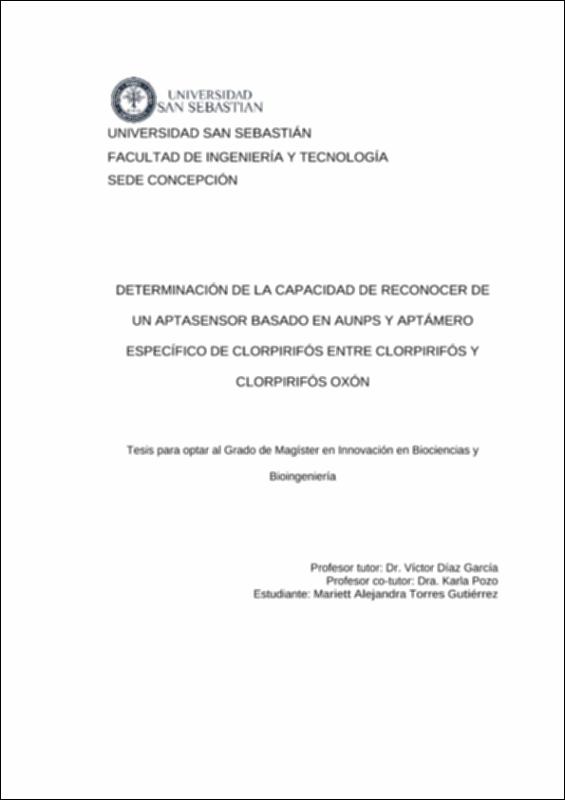- Inicio
- >
- Facultades
- >
- Ingeniería
- >
- Magíster en Innovación en Biociencias y Bioingeniería
- >
- Ver ítem
JavaScript is disabled for your browser. Some features of this site may not work without it.
Descubre información por...
Buscar documentos por...

Temporalmente, el archivo digital asociado a esta publicación, no se encuentra disponible. Para más información escribir a [email protected]
Determinación de la capacidad de reconocer de un aptasensor basado en Aunps y Aptaméro específico de Clorpirofós entre Clorpirofós y Clorpirofós Oxón
|
Autor(es)
Torres Gutiérrez, Mariett Alejandra |
|
Profesor Tutor:
Díaz García, Víctor |
|
Idioma:
es |
|
Programa:
Postgrado |
|
Materia:
TESIS MAGÍSTER; CLOROPIRIFOS; CONTAMINANTES DEL AGUA |
|
Fecha:
2022 |
|
Tipo:
Tesis |
|
Descripción:
Magíster en Innovación en Biociencias y Bioingeniería |
|
Resumen:
El clorpirifós es el segundo pesticida más detectado en productos alimentarios y en el agua lo que ha motivado una exponencial preocupación por concepto de pérdida de biodiversidad, riesgos viables para la salud de las personas y otros organismos no objetivos. Una de las acciones relevantes para el manejo de este contaminante es la detección temprana, pero esta presenta varios desafíos asociados a la movilidad del plaguicida, factores naturales como la biodegradación, la fotodegradación y la hidrólisis química disminuyen su persistencia y ecotoxicidad en el medio ambiente y los desafíos asociados a su detección analítica como los procedimientos de muestreos en terrenos, contenedores para tomas de muestras, almacenamientos adecuados, pretratamientos de la muestra, mayores volúmenes de solvente y costos asociados a personal en terreno y de análisis de residuos basados en cromatografía de gases y cromatografía líquida. Para superar los inconvenientes de los métodos tradicionales, se ha trabajado en el desarrollo de nanobiosensores, que permitirían la detección de contaminantes en terreno, favoreciendo el seguimiento de la descarga de contaminantes al medioambiente. Pero, clorpirifós se degrada en el medio ambiente, por lo que determinar si los nanobiosensores desarrollados para clorpirifós son capaces de detectarlos productos de degradación de CP, es relevante para establecer las reales capacidades de detección de estos dispositivos. Por estos motivos, este trabajo aborda el desarrollo de un nanoaptasensor (NAS) basado en nanopartículas de oro (AuNPs) unidas a aptámero específico para clorpirifós, estandarizando las condiciones de funcionamiento del NAS, para posteriormente, determinar la capacidad de este NAS para detectar clorpirifós- oxon, uno de los primeros metabolitos producidos por la degradación de clorpirifós. Los resultados mostraron que trabajar con una proporción molar de AuNPs: aptámero de 1:20, bajo condiciones de pH a 6,5 y 1,5 M de NaCl como agente revelador permitieron detectar un mínimo de 60 ppb de clorpirifós en agua. Con estos resultados, se proyecta avanzar en desafiar al NAS para determinar su capacidad de detección de clorpirifós-oxon. Chlorpyrifos is the second most detected pesticide in food products and in water, which has caused an exponential concern due to the loss of biodiversity, viable risks to the health of people and other non-target organisms. One of the relevant actions for the management of this contaminant is early detection, but this presents several challenges associated with the mobility of the pesticide, natural factors such as biodegradation, photodegradation and chemical hydrolysis that reduce its persistence and ecotoxicity in the environment and the challenges associated with its analytical detection such as field sampling procedures, sampling containers, adequate storage, sample pretreatment, higher volumes of solvent and costs associated with field personnel and gas chromatography-based residue analysis and liquid chromatography. To overcome the drawbacks of traditional methods, work has been done on the development of nanobiosensors, which would allow the detection of pollutants in the field, favoring the monitoring of the discharge of pollutants into the environment. However, chlorpyrifos degrades in the environment, so determining whether the nanobiosensors developed for chlorpyrifos are capable of detecting CP degradation products is relevant to establish the real detection capabilities of these devices. For these reasons, this work deals with the development of a nanoaptasensor (NAS) based on gold nanoparticles (AuNPs) linked to a specific aptamer for chlorpyrifos, standardizing the operating conditions of the NAS, to later determine the capacity of this NAS to detect chlorpyrifos. - oxon, one of the first metabolites produced by the degradation of chlorpyrifos. The results showed that working with a molar ratio of AuNPs: aptamer of 1:20, under conditions of pH at 6.5 and 1.5 M NaCl as revealing agent, allowed detecting a minimum of 60 ppb of chlorpyrifos in water. With these results, it is planned to move forward in challenging the NAS to determine its ability to detect chlorpyrifos-oxon. |
Este ítem aparece en la(s) siguiente(s) colección(ones)
Buscar
Listar
-
Todo el Repositorio
-
Esta colección
Mi cuenta
Acerca de
El Repositorio Institucional de la Universidad San Sebastián reúne los trabajos académicos y de investigación elaborados por la comunidad universitaria. Contribuye a la visibilidad y difusión, para ser consultados a través de acceso abierto por toda la comunidad nacional e internacional.
El objetivo del Repositorio es almacenar, conservar y entregar en formato electrónico, los resultados del quehacer institucional, permitiendo mayor visibilidad y difusión por medio del acceso abierto y gratuito.


